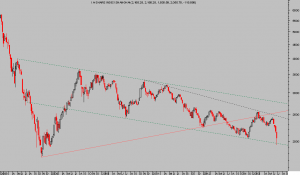Un informe de JP Morgan revela una interesante explicación sobre la crisis del interbancario sufrida la semana pasada en China:
JPMorgan… there is an additional reason for the tight liquidity, in the form of a crackdown on illegal bond trading by regulators. In recent years, wealth management products (WMP) have become an important channel for Chinese banks to attract deposits. Most wealth management products are short-maturity (65% are below 3 months, and 20% range from 3-6 months). The maturity dates of such products are usually at the quarter-end, to meet regulatory requirements on loan-to-deposit ratios. Due to competition in providing high returns for WMP, banks were forced to buy high-yielding bonds with 1-5-year maturities to serve as underlying of the WMP. Examples of such bonds are lowly rated credit papers with poor liquidity, or non-standard securities such as discounted bills and bank loans. This resulted in a term mismatch between the maturity of WMP and their underlying asset. To avoid any squeeze from this mismatch upon maturity of the WMP, small banks started to engage in a kind of sale-and-buyback operation of the underlying bonds, consisting of two steps. In step 1, bonds were sold before quarter-end in a “fake” sale to a friendly counterparty, with the aim to obtain cash to pay back the maturing WMP. In a second phase of the trade, the bond was then bought back using cash from new WMP issues. But in May the regulator banned this practice, as part of a general clampdown of the abuses in the WPM market. Part of the interest rate squeeze we are observing today is due to the difficulty in liquidating the (illiquid) underlying bonds before the maturity date of WMP at June-end. The demand for cash has therefore risen significantly, at least from the small banks. Note that China’s larger banks do not have problems accessing liquidity, but that primarily the small banks are suffering».
El desplome de la bolsa china estuvo relacionado con la crisis de liquidez, los agentas financieros se vieron obligados a vender bolsa para conseguir liquidez y la caída se retroalimentó, provocando una durísima caída de las cotizaciones. El índice de Shangai abrió la semana cayendo un 5.5%.
En el escrito del lunes comentaba a este respecto «El índice se Shangai ha perdido como decía un 5.5%, quedando por debajo de los 2.000 puntos y a un escaso 10% de los mínimos de 2008. La zona de cierres, 1963 puntos, se configura como un soporte técnico relevante a defender, de no ser así, la probabilidad de descenso en busca de los 1750 puntos, mínimos de octubre de 2008, será muy elevada.»
A-SHARE SHANGAI INDEX, Semanal
El mercado chino ha conseguido recuperar niveles en las sesiones del martes y miércoles, respetando la estructura técnica y mostrando intenciones de recuperar lo perdido en las últimas semanas… aún así, todavía es pronto para confirmar.
